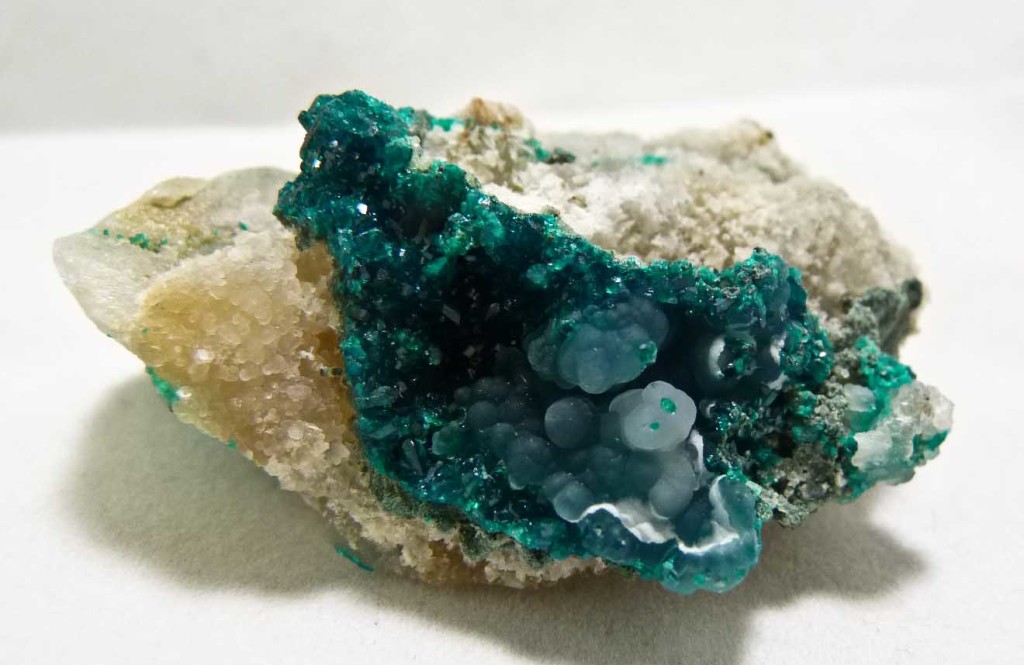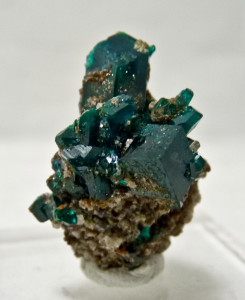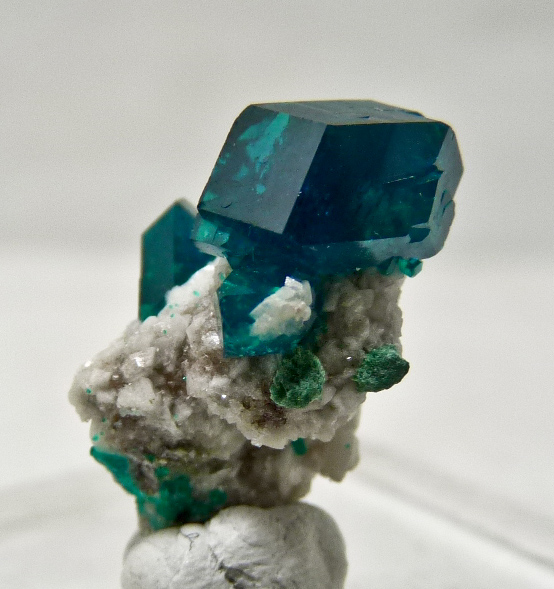Dioptase is one of the most gorgeous and valuable minerals on Earth due to its high quality crystallization, amazing color, and rarity. Chemically, dioptase is a trigonal hydrated copper silicate- CuSiO3·H2O. It forms large rhombohedral crystals in oxidized copper ores that grow up to 3cm, though very uncommonly they can be larger.  Dioptase is commonly associated with calcite and quartz as well as many other copper and lead secondary minerals such as malachite, chrysocolla, plancheite, shattuckite, wulfenite, descloizite, mottramite, and duftite, all of these forming from weathering hydrothermally formed copper sulfides. Dioptase requires natural buffering of acidic solutions leaching from weathering copper sulfides to form because the solubility of silica and silicate anions in aqueous solution is proportional to pH and steeply reduced at lower pHs. Buffering is often facilitated by the presence of calcite in limestone. The calcite dissolves when attacked by protons in acidic solutions forming water and carbon dioxide which is emitted as a gas. Typically, when this kind of acid buffering occurs, chrysocolla is formed but under rare circumstances where the concentrations of copper and dissolved silica are correct and gorgeous crystals of dioptase grow!
Dioptase is commonly associated with calcite and quartz as well as many other copper and lead secondary minerals such as malachite, chrysocolla, plancheite, shattuckite, wulfenite, descloizite, mottramite, and duftite, all of these forming from weathering hydrothermally formed copper sulfides. Dioptase requires natural buffering of acidic solutions leaching from weathering copper sulfides to form because the solubility of silica and silicate anions in aqueous solution is proportional to pH and steeply reduced at lower pHs. Buffering is often facilitated by the presence of calcite in limestone. The calcite dissolves when attacked by protons in acidic solutions forming water and carbon dioxide which is emitted as a gas. Typically, when this kind of acid buffering occurs, chrysocolla is formed but under rare circumstances where the concentrations of copper and dissolved silica are correct and gorgeous crystals of dioptase grow!
 Dioptase, despite its simple composition is a relatively rare mineral. It is only found in high quality crystals at a few localities worldwide, the majority of which being in Africa. Despite the limited distribution of the species worldwide, dioptase often occurs in very high It was originally discovered at a small copper deposit in Altyn Tyube, Kazakhstan which is in a very isolated portion of the Central Asian steppe. Here, the dioptase was confused for emerald by Russian and Kazakh miners and thought to be an extremely high grade deposit. Famous french mineralogist René Just Haüy determined that these then unknown crystals were a new mineral due to their hardness, which is less than that of emerald, presence of copper, and crystallography and in 1797, announced the discovery and chose the name dioptase for the mineral’s two cleavage angles which are very visible in crystals. Many fine specimens are still recovered from Altyn Tyube and green dioptase staining is observed abundantly on rocks everywhere near the site!
Dioptase, despite its simple composition is a relatively rare mineral. It is only found in high quality crystals at a few localities worldwide, the majority of which being in Africa. Despite the limited distribution of the species worldwide, dioptase often occurs in very high It was originally discovered at a small copper deposit in Altyn Tyube, Kazakhstan which is in a very isolated portion of the Central Asian steppe. Here, the dioptase was confused for emerald by Russian and Kazakh miners and thought to be an extremely high grade deposit. Famous french mineralogist René Just Haüy determined that these then unknown crystals were a new mineral due to their hardness, which is less than that of emerald, presence of copper, and crystallography and in 1797, announced the discovery and chose the name dioptase for the mineral’s two cleavage angles which are very visible in crystals. Many fine specimens are still recovered from Altyn Tyube and green dioptase staining is observed abundantly on rocks everywhere near the site!
Dioptase is a staple for any high quality mineral collection that represents international localities. A good miniature to small cabinet specimen of dioptase will typically cost over $500 but will add a magnificent shimmer and special splash of emerald green color that will draw eyes to your cabinet of minerals! The best dioptase specimens are often in in the $1000 to $5000 range though rightfully so- they represent the highest standard in nature’s beauty. For the gem collector, faceted dioptase is available only rarely and is not appropriate for jewelry because it is so soft and can be chipped when dropped. Choosing a solid dioptase specimen is a great first task to build your skills in planning a fine mineral collection!

